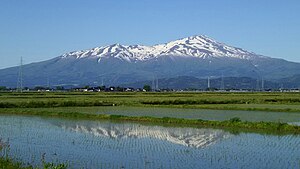Omonoimi no Kami

Omonoiminokami (大物忌神) is a god who is said to reside on Mount Chōkai in Yamagata Prefecture . There are shrines that enshrine Omonoiminokami in various places in the Tohoku region, including Chokaisan Ōmonoimi Shrine on the summit of Mount Chōkai, and Chōkai gassan ryōsho-gu.[1]
Ōmonoimi-no-kami (大物忌神) is considered possibly identical to Toyouke-hime[a] [2]
Overview
[change | change source]Mount Chōkai is in the northern area of Yamato sovereignty. The people there believed that Daimotsui no kami protected their nation and purified kegare. The mountain is a volcano, and there have been eruptions in the past.
Omonoimimi no kami is considered to be the same deity as Uka no mitama, Toyouke no Okami,[2] Oimimi no kami, and Hirose no kami. According to the shrine tradition of Chokaisan Daimotsui-jinja Shrine, it is the same deity as Toyouke Omikami of Jingu Geku.
Chokai Gassan Ryoshonomiya enshrines Kurinama no Mikoto as the deity of Mt. Chokai.
According to legend, a three legged crow, a sacred crow, was sent to observe the evil deeds of a being with long arms. The raven would make a sound of "Yes" to signal the appearance of the being and "Muya" when it did not appear. This is said to be why the Misaki Pass at the base of the mountain is called "Yuyamuya no Seki".[3]
Every time Mount Chōkai erupted his rank increased[4]
Notelist
[change | change source]- ↑ Ōmonoimi-no-kami is believed to be the god of Mount Chōkai in Yamagata prefecture, or the northernmost post of the land of Yamato.
References
[change | change source]- ↑ "鳥海月山両所宮". www.komainu.org. Retrieved 2023-04-12.
- ↑ 2.0 2.1 Sonoda, Minoru [in Japanese]; Mogi, Sakae (1997). Nihon no kamigami no jiten : Shinto saishi to yaoyorozu no kamigami. Books esoterica, 2.; New sight mook (in Japanese). Gakken. pp. 68, 69. ISBN 9784056016291. OCLC 42978057.
- ↑ "三崎公園・有耶無耶の関". town.yuza.yamagata.jp. 遊佐町産業振興課. Archived from the original on 2007-12-18. Retrieved 2009-01-31.
- ↑ "Tallest Peak in North Japan: The Shugen History of Chokai-san". Tim Bunting. Retrieved 2023-05-10.
